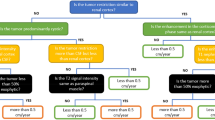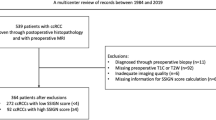Abstract
Purpose
Upfront knowledge of tumor growth rates of clear cell renal cell carcinoma in von Hippel-Lindau syndrome (VHL) patients can allow for a more personalized approach to either surveillance imaging frequency or surgical planning. In this study, we implement a machine learning algorithm utilizing radiomic features of renal tumors identified on baseline magnetic resonance imaging (MRI) in VHL patients to predict the volumetric growth rate category of these tumors.
Materials and Methods
A total of 73 VHL patients with 173 pathologically confirmed Clear Cell Renal Cell Carcinoma (ccRCCs) underwent MRI at least at two different time points between 2015 and 2021. Each tumor was manually segmented in excretory phase contrast T1 weighed MRI and co-registered on pre-contrast, corticomedullary and nephrographic phases. Radiomic features and volumetric data from each tumor were extracted using the PyRadiomics library in Python (4544 total features). Tumor doubling time (DT) was calculated and patients were divided into two groups: DT < = 1 year and DT > 1 year. Random forest classifier (RFC) was used to predict the DT category. To measure prediction performance, the cohort was randomly divided into 100 training and test sets (80% and 20%). Model performance was evaluated using area under curve of receiver operating characteristic curve (AUC-ROC), as well as accuracy, F1, precision and recall, reported as percentages with 95% confidence intervals (CIs).
Results
The average age of patients was 47.2 ± 10.3 years. Mean interval between MRIs for each patient was 1.3 years. Tumors included in this study were categorized into 155 Grade 2; 16 Grade 3; and 2 Grade 4. Mean accuracy of RFC model was 79.0% [67.4–90.6] and mean AUC-ROC of 0.795 [0.608–0.988]. The accuracy for predicting DT classes was not different among the MRI sequences (P-value = 0.56).
Conclusion
Here we demonstrate the utility of machine learning in accurately predicting the renal tumor growth rate category of VHL patients based on radiomic features extracted from different T1-weighted pre- and post-contrast MRI sequences.




Similar content being viewed by others
Abbreviations
- ccRCC:
-
Clear Cell Renal Cell Carcinoma
- VHL:
-
Von Hippel-Lindau
- RFC:
-
Random Forest Classifier
- AUC:
-
Area Under the curve
- ROC:
-
Receiver operating characteristic curve
- CI:
-
Confidence interval
References
Gläsker S, Vergauwen E, Koch CA, Kutikov A, Vortmeyer AO. Von Hippel-Lindau Disease: Current Challenges and Future Prospects. Onco Targets Ther. 2020;13:5669-90.
FJ OB, Danapal M, Jairam S, Lalani AK, Cunningham J, Morrin M, et al. Manifestations of Von Hippel Lindau syndrome: a retrospective national review. Qjm. 2014;107(4):291–6.
Kim HS, Kim JH, Jang HJ, Han B, Zang DY. Clinicopathologic Significance of VHL Gene Alteration in Clear-Cell Renal Cell Carcinoma: An Updated Meta-Analysis and Review. Int J Mol Sci. 2018;19(9).
Kim E, Zschiedrich S. Renal Cell Carcinoma in von Hippel-Lindau Disease-From Tumor Genetics to Novel Therapeutic Strategies. Frontiers in pediatrics. 2018;6:16-.
Williamson SR. Clear cell papillary renal cell carcinoma: an update after 15 years. Pathology. 2021;53(1):109-19.
Maher ER. Hereditary renal cell carcinoma syndromes: diagnosis, surveillance and management. World journal of urology. 2018;36(12):1891-8.
Binderup ML, Bisgaard ML, Harbud V, Møller HU, Gimsing S, Friis-Hansen L, et al. Von Hippel-Lindau disease (vHL). National clinical guideline for diagnosis and surveillance in Denmark. 3rd edition. Dan Med J. 2013;60(12):B4763.
Ball MW, An JY, Gomella PT, Gautam R, Ricketts CJ, Vocke CD, et al. Growth Rates of Genetically Defined Renal Tumors: Implications for Active Surveillance and Intervention. J Clin Oncol. 2020;38(11):1146-53.
Zhang L, Yao L, Li X, Jewett MAS, He Z, Zhou L. Natural history of renal cell carcinoma: An immunohistochemical analysis of growth rate in patients with delayed treatment. Journal of the Formosan Medical Association. 2016;115(6):463-9.
Nerli R, Devaraju S, Hiremath MB, Guntaka AK, Patne P, Dixit N. Tumor doubling time of renal cell carcinoma measured by CT. Indian J Urol. 2014;30(2):153-7.
Li Z, Zhang J, Zhang L, Yao L, Zhang C, He Z, et al. Natural history and growth kinetics of clear cell renal cell carcinoma in sporadic and von Hippel-Lindau disease. Translational andrology and urology. 2021;10(3):1064-70.
Gopal N, Yazdian Anari P, Turkbey E, Jones EC, Malayeri AA. The Next Paradigm Shift in the Management of Clear Cell Renal Cancer: Radiogenomics—Definition, Current Advances, and Future Directions. Cancers. 2022;14(3):793.
Harris PA, Taylor R, Thielke R, Payne J, Gonzalez N, Conde JG. Research electronic data capture (REDCap)--a metadata-driven methodology and workflow process for providing translational research informatics support. Journal of biomedical informatics. 2009;42(2):377-81.
Van Griethuysen JJ, Fedorov A, Parmar C, Hosny A, Aucoin N, Narayan V, et al. Computational radiomics system to decode the radiographic phenotype. Cancer research. 2017;77(21):e104-e7.
Gotchev A, Vesma J, Saramaki T, Egiazarian K, editors. Digital image resampling by modified B-spline functions. IEEE Nordic Signal Processing Symposium; 2000: Citeseer.
Chawla NV, Bowyer KW, Hall LO, Kegelmeyer WP. SMOTE: synthetic minority over-sampling technique. Journal of artificial intelligence research. 2002;16:321-57.
Pedregosa F, Varoquaux G, Gramfort A, Michel V, Thirion B, Grisel O, et al. Scikit-learn: Machine learning in Python. the Journal of machine Learning research. 2011;12:2825–30.
McAlpine K, Finelli A. Natural history of untreated kidney cancer. World Journal of Urology. 2021;39(8):2825-9.
Kuusk T, Neves JB, Tran M, Bex A. Radiomics to better characterize small renal masses. World J Urol. 2021;39(8):2861-8.
Mehrazin R, Smaldone MC, Egleston B, Tomaszewski JJ, Concodora CW, Ito TK, et al. Is anatomic complexity associated with renal tumor growth kinetics under active surveillance? Urol Oncol. 2015;33(4):167.e7-12.
Matsumoto R, Abe T, Shinohara N, Murai S, Maruyama S, Tsuchiya K, et al. RENAL nephrometry score is a predictive factor for the annual growth rate of renal mass. Int J Urol. 2014;21(6):549-52.
Dodelzon K, Mussi TC, Babb JS, Taneja SS, Rosenkrantz AB. Prediction of Growth Rate of Solid Renal Masses: Utility of MR Imaging Features–Preliminary Experience. Radiology. 2012;262(3):884-93.
Zhang L, Yin W, Yao L, Li X, Fang D, Ren D, et al. Growth Pattern of Clear Cell Renal Cell Carcinoma in Patients with Delayed Surgical Intervention: Fast Growth Rate Correlates with High Grade and May Result in Poor Prognosis. Biomed Res Int. 2015;2015:598134-.
Farhadi F, Nikpanah M, Paschall AK, Shafiei A, Tadayoni A, Ball MW, et al. Clear Cell Renal Cell Carcinoma Growth Correlates with Baseline Diffusion-weighted MRI in Von Hippel-Lindau Disease. Radiology. 2020;295(3):583-90.
Author information
Authors and Affiliations
Corresponding authors
Ethics declarations
Informed consent
This single-institution study was approved by the institutional review board. Written informed consent was obtained from all patients.
Additional information
Publisher's Note
Springer Nature remains neutral with regard to jurisdictional claims in published maps and institutional affiliations.
Supplementary Information
Below is the link to the electronic supplementary material.
Rights and permissions
About this article
Cite this article
Anari, P.Y., Lay, N., Gopal, N. et al. An MRI-based radiomics model to predict clear cell renal cell carcinoma growth rate classes in patients with von Hippel-Lindau syndrome. Abdom Radiol 47, 3554–3562 (2022). https://doi.org/10.1007/s00261-022-03610-5
Received:
Revised:
Accepted:
Published:
Issue Date:
DOI: https://doi.org/10.1007/s00261-022-03610-5




